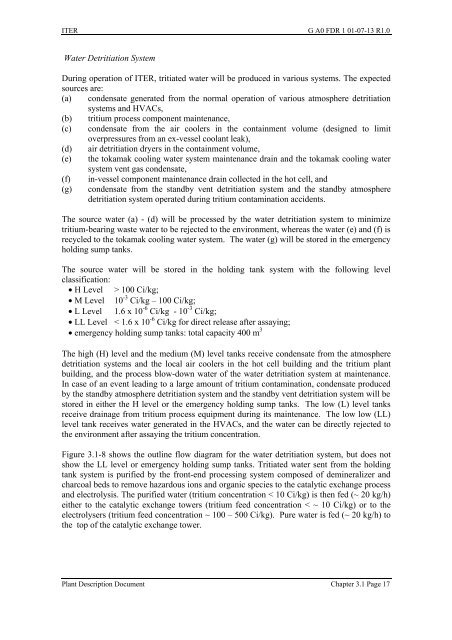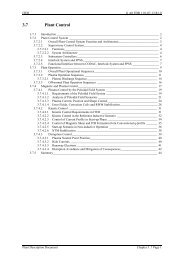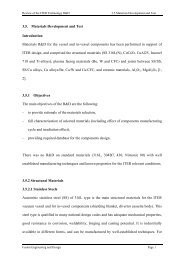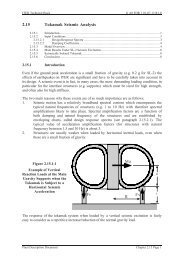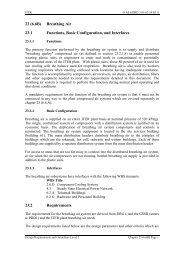3.1 Tritium Plant and Detritiation - General Atomics Fusion Group
3.1 Tritium Plant and Detritiation - General Atomics Fusion Group
3.1 Tritium Plant and Detritiation - General Atomics Fusion Group
- No tags were found...
Create successful ePaper yourself
Turn your PDF publications into a flip-book with our unique Google optimized e-Paper software.
ITER G A0 FDR 1 01-07-13 R1.0Water <strong>Detritiation</strong> SystemDuring operation of ITER, tritiated water will be produced in various systems. The expectedsources are:(a) condensate generated from the normal operation of various atmosphere detritiationsystems <strong>and</strong> HVACs,(b) tritium process component maintenance,(c) condensate from the air coolers in the containment volume (designed to limitoverpressures from an ex-vessel coolant leak),(d) air detritiation dryers in the containment volume,(e) the tokamak cooling water system maintenance drain <strong>and</strong> the tokamak cooling watersystem vent gas condensate,(f) in-vessel component maintenance drain collected in the hot cell, <strong>and</strong>(g) condensate from the st<strong>and</strong>by vent detritiation system <strong>and</strong> the st<strong>and</strong>by atmospheredetritiation system operated during tritium contamination accidents.The source water (a) - (d) will be processed by the water detritiation system to minimizetritium-bearing waste water to be rejected to the environment, whereas the water (e) <strong>and</strong> (f) isrecycled to the tokamak cooling water system. The water (g) will be stored in the emergencyholding sump tanks.The source water will be stored in the holding tank system with the following levelclassification:• H Level > 100 Ci/kg;• M Level 10 -3 Ci/kg – 100 Ci/kg;• L Level 1.6 x 10 -6 Ci/kg - 10 -3 Ci/kg;• LL Level < 1.6 x 10 -6 Ci/kg for direct release after assaying;• emergency holding sump tanks: total capacity 400 m 3The high (H) level <strong>and</strong> the medium (M) level tanks receive condensate from the atmospheredetritiation systems <strong>and</strong> the local air coolers in the hot cell building <strong>and</strong> the tritium plantbuilding, <strong>and</strong> the process blow-down water of the water detritiation system at maintenance.In case of an event leading to a large amount of tritium contamination, condensate producedby the st<strong>and</strong>by atmosphere detritiation system <strong>and</strong> the st<strong>and</strong>by vent detritiation system will bestored in either the H level or the emergency holding sump tanks. The low (L) level tanksreceive drainage from tritium process equipment during its maintenance. The low low (LL)level tank receives water generated in the HVACs, <strong>and</strong> the water can be directly rejected tothe environment after assaying the tritium concentration.Figure <strong>3.1</strong>-8 shows the outline flow diagram for the water detritiation system, but does notshow the LL level or emergency holding sump tanks. Tritiated water sent from the holdingtank system is purified by the front-end processing system composed of demineralizer <strong>and</strong>charcoal beds to remove hazardous ions <strong>and</strong> organic species to the catalytic exchange process<strong>and</strong> electrolysis. The purified water (tritium concentration < 10 Ci/kg) is then fed (~ 20 kg/h)either to the catalytic exchange towers (tritium feed concentration < ~ 10 Ci/kg) or to theelectrolysers (tritium feed concentration ~ 100 – 500 Ci/kg). Pure water is fed (~ 20 kg/h) tothe top of the catalytic exchange tower.<strong>Plant</strong> Description Document Chapter <strong>3.1</strong> Page 17


